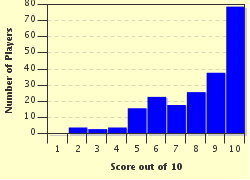Quiz Answer Key and Fun Facts
1. What did Percy Spencer invent in 1945?
2. Who invented the paper coffee filter in 1908?
3. What was Roy Plunkett's contribution to cooking?
4. Which soft drink was invented by John Pemberton?
5. It seems obvious that the same person invented the crown cork and the bottle opener, as one invention serves only to open what the other invention has closed. Who invented this method of conserving liquids such as beer and soft drinks?
6. I've used an invention of Arthur Fry to remind me to bring milk from the supermarket. What did Arthur Fry invent?
7. Who invented the thermos flask?
8. What did Josephine Cochrane invent?
9. Who produced the first artificial refrigerator in 1755?
10. Something to smile at. What is the purpose of the Ostehovel invented by Thor Bjorklund?
Source: Author
JanIQ
This quiz was reviewed by FunTrivia editor
bloomsby before going online.
Any errors found in FunTrivia content are routinely corrected through our feedback system.


